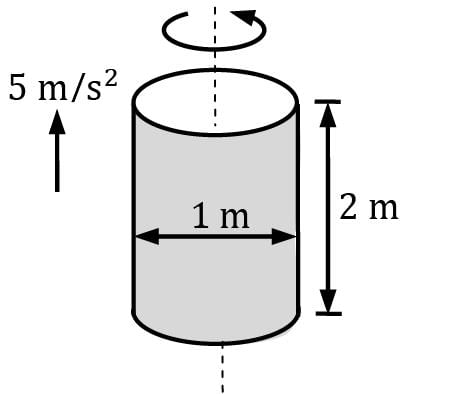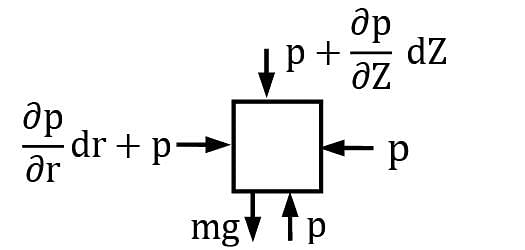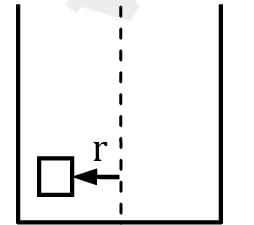Civil Engineering (CE) Exam > Civil Engineering (CE) Questions > A 1-m-diameter, 2-m-high vertical cylinder i...
Start Learning for Free
A 1-m-diameter, 2-m-high vertical cylinder is completely filled with gasoline whose density is 740 kg/m3. The tank is now rotated about its vertical axis at a rate of 90 rpm, while being accelerated upward at 5 m/s2. Determine
(i) the difference between the pressure at the centers of the bottom and top surfaces
(ii) the difference between the pressures at the center and the edge of the bottom surface.

- a)22 kPa and 8.2 kPa respectively
- b)8.2 kPa and 22 kPa respectively
- c)18.7 kPa and 11.2 kPa respectively
- d)11.2 kPa and 18.7 kPa respectively
Correct answer is option 'A'. Can you explain this answer?
Verified Answer
A 1-m-diameter, 2-m-high vertical cylinder is completely filled with ...

Considering a small fluid element

Resolving forces in z-direction, pdA − (p + ∂p / ∂z dz) dA − ρdAdzg = ρdAdz. a
⇒ − ∂p / ∂z dz = ρ(g + a)dz
Again resolving forces along r − (p + ∂p ∂r dr) dA + pdA + ρdAdrω2r = 0
[ρdAdrω2 r is the centrifugal force]
⇒∂p / ∂r dr = ρω2 rdr
Also we can write dp = ∂p / ∂r dr + ∂p / ∂z dz
∴ dp = ρω2rdr − ρ(a + g)dz
Which gives p = ρω2r2 / 2− ρ(a + g)z + C
(a) The difference of pressure at the center (r = 0) of top & bottom surface
Δp = Pbottom − Ptop
⇒ Δp = [−ρ(a + g)0 + C] − [−ρ(a + g)(2) + C]
⇒ Δp = ρ(a + g)(2)
⇒ Δp = 21.91 kPa
(b) The difference of pressure at the center and edge of bottom surface (Z = 0)
Δp = ρω2(0.5) 2/ 2
⇒ Δp = ρ × (N/60× 2π)2× (0.5)2 / 2
⇒ Δp = 8.21 kPa
Most Upvoted Answer
A 1-m-diameter, 2-m-high vertical cylinder is completely filled with ...

Considering a small fluid element

Resolving forces in z-direction, pdA − (p + ∂p / ∂z dz) dA − ρdAdzg = ρdAdz. a
⇒ − ∂p / ∂z dz = ρ(g + a)dz
Again resolving forces along r − (p + ∂p ∂r dr) dA + pdA + ρdAdrω2r = 0
[ρdAdrω2 r is the centrifugal force]
⇒∂p / ∂r dr = ρω2 rdr
Also we can write dp = ∂p / ∂r dr + ∂p / ∂z dz
∴ dp = ρω2rdr − ρ(a + g)dz
Which gives p = ρω2r2 / 2− ρ(a + g)z + C
(a) The difference of pressure at the center (r = 0) of top & bottom surface
Δp = Pbottom − Ptop
⇒ Δp = [−ρ(a + g)0 + C] − [−ρ(a + g)(2) + C]
⇒ Δp = ρ(a + g)(2)
⇒ Δp = 21.91 kPa
(b) The difference of pressure at the center and edge of bottom surface (Z = 0)
Δp = ρω2(0.5) 2/ 2
⇒ Δp = ρ × (N/60× 2π)2× (0.5)2 / 2
⇒ Δp = 8.21 kPa
Free Test
FREE
| Start Free Test |
Community Answer
A 1-m-diameter, 2-m-high vertical cylinder is completely filled with ...

Considering a small fluid element

Resolving forces in z-direction, pdA − (p + ∂p / ∂z dz) dA − ρdAdzg = ρdAdz. a
⇒ − ∂p / ∂z dz = ρ(g + a)dz
Again resolving forces along r − (p + ∂p ∂r dr) dA + pdA + ρdAdrω2r = 0
[ρdAdrω2 r is the centrifugal force]
⇒∂p / ∂r dr = ρω2 rdr
Also we can write dp = ∂p / ∂r dr + ∂p / ∂z dz
∴ dp = ρω2rdr − ρ(a + g)dz
Which gives p = ρω2r2 / 2− ρ(a + g)z + C
(a) The difference of pressure at the center (r = 0) of top & bottom surface
Δp = Pbottom − Ptop
⇒ Δp = [−ρ(a + g)0 + C] − [−ρ(a + g)(2) + C]
⇒ Δp = ρ(a + g)(2)
⇒ Δp = 21.91 kPa
(b) The difference of pressure at the center and edge of bottom surface (Z = 0)
Δp = ρω2(0.5) 2/ 2
⇒ Δp = ρ × (N/60× 2π)2× (0.5)2 / 2
⇒ Δp = 8.21 kPa

|
Explore Courses for Civil Engineering (CE) exam
|

|
Similar Civil Engineering (CE) Doubts
A 1-m-diameter, 2-m-high vertical cylinder is completely filled with gasoline whose density is 740 kg/m3. The tank is now rotated about its vertical axis at a rate of 90 rpm, while being accelerated upward at 5 m/s2. Determine(i) the difference between the pressure at the centers of the bottom and top surfaces(ii) the difference between the pressures at the center and the edge of the bottom surface.a) 22 kPa and 8.2 kPa respectivelyb) 8.2 kPa and 22 kPa respectivelyc) 18.7 kPa and 11.2 kPa respectivelyd) 11.2 kPa and 18.7 kPa respectivelyCorrect answer is option 'A'. Can you explain this answer?
Question Description
A 1-m-diameter, 2-m-high vertical cylinder is completely filled with gasoline whose density is 740 kg/m3. The tank is now rotated about its vertical axis at a rate of 90 rpm, while being accelerated upward at 5 m/s2. Determine(i) the difference between the pressure at the centers of the bottom and top surfaces(ii) the difference between the pressures at the center and the edge of the bottom surface.a) 22 kPa and 8.2 kPa respectivelyb) 8.2 kPa and 22 kPa respectivelyc) 18.7 kPa and 11.2 kPa respectivelyd) 11.2 kPa and 18.7 kPa respectivelyCorrect answer is option 'A'. Can you explain this answer? for Civil Engineering (CE) 2025 is part of Civil Engineering (CE) preparation. The Question and answers have been prepared according to the Civil Engineering (CE) exam syllabus. Information about A 1-m-diameter, 2-m-high vertical cylinder is completely filled with gasoline whose density is 740 kg/m3. The tank is now rotated about its vertical axis at a rate of 90 rpm, while being accelerated upward at 5 m/s2. Determine(i) the difference between the pressure at the centers of the bottom and top surfaces(ii) the difference between the pressures at the center and the edge of the bottom surface.a) 22 kPa and 8.2 kPa respectivelyb) 8.2 kPa and 22 kPa respectivelyc) 18.7 kPa and 11.2 kPa respectivelyd) 11.2 kPa and 18.7 kPa respectivelyCorrect answer is option 'A'. Can you explain this answer? covers all topics & solutions for Civil Engineering (CE) 2025 Exam. Find important definitions, questions, meanings, examples, exercises and tests below for A 1-m-diameter, 2-m-high vertical cylinder is completely filled with gasoline whose density is 740 kg/m3. The tank is now rotated about its vertical axis at a rate of 90 rpm, while being accelerated upward at 5 m/s2. Determine(i) the difference between the pressure at the centers of the bottom and top surfaces(ii) the difference between the pressures at the center and the edge of the bottom surface.a) 22 kPa and 8.2 kPa respectivelyb) 8.2 kPa and 22 kPa respectivelyc) 18.7 kPa and 11.2 kPa respectivelyd) 11.2 kPa and 18.7 kPa respectivelyCorrect answer is option 'A'. Can you explain this answer?.
A 1-m-diameter, 2-m-high vertical cylinder is completely filled with gasoline whose density is 740 kg/m3. The tank is now rotated about its vertical axis at a rate of 90 rpm, while being accelerated upward at 5 m/s2. Determine(i) the difference between the pressure at the centers of the bottom and top surfaces(ii) the difference between the pressures at the center and the edge of the bottom surface.a) 22 kPa and 8.2 kPa respectivelyb) 8.2 kPa and 22 kPa respectivelyc) 18.7 kPa and 11.2 kPa respectivelyd) 11.2 kPa and 18.7 kPa respectivelyCorrect answer is option 'A'. Can you explain this answer? for Civil Engineering (CE) 2025 is part of Civil Engineering (CE) preparation. The Question and answers have been prepared according to the Civil Engineering (CE) exam syllabus. Information about A 1-m-diameter, 2-m-high vertical cylinder is completely filled with gasoline whose density is 740 kg/m3. The tank is now rotated about its vertical axis at a rate of 90 rpm, while being accelerated upward at 5 m/s2. Determine(i) the difference between the pressure at the centers of the bottom and top surfaces(ii) the difference between the pressures at the center and the edge of the bottom surface.a) 22 kPa and 8.2 kPa respectivelyb) 8.2 kPa and 22 kPa respectivelyc) 18.7 kPa and 11.2 kPa respectivelyd) 11.2 kPa and 18.7 kPa respectivelyCorrect answer is option 'A'. Can you explain this answer? covers all topics & solutions for Civil Engineering (CE) 2025 Exam. Find important definitions, questions, meanings, examples, exercises and tests below for A 1-m-diameter, 2-m-high vertical cylinder is completely filled with gasoline whose density is 740 kg/m3. The tank is now rotated about its vertical axis at a rate of 90 rpm, while being accelerated upward at 5 m/s2. Determine(i) the difference between the pressure at the centers of the bottom and top surfaces(ii) the difference between the pressures at the center and the edge of the bottom surface.a) 22 kPa and 8.2 kPa respectivelyb) 8.2 kPa and 22 kPa respectivelyc) 18.7 kPa and 11.2 kPa respectivelyd) 11.2 kPa and 18.7 kPa respectivelyCorrect answer is option 'A'. Can you explain this answer?.
Solutions for A 1-m-diameter, 2-m-high vertical cylinder is completely filled with gasoline whose density is 740 kg/m3. The tank is now rotated about its vertical axis at a rate of 90 rpm, while being accelerated upward at 5 m/s2. Determine(i) the difference between the pressure at the centers of the bottom and top surfaces(ii) the difference between the pressures at the center and the edge of the bottom surface.a) 22 kPa and 8.2 kPa respectivelyb) 8.2 kPa and 22 kPa respectivelyc) 18.7 kPa and 11.2 kPa respectivelyd) 11.2 kPa and 18.7 kPa respectivelyCorrect answer is option 'A'. Can you explain this answer? in English & in Hindi are available as part of our courses for Civil Engineering (CE).
Download more important topics, notes, lectures and mock test series for Civil Engineering (CE) Exam by signing up for free.
Here you can find the meaning of A 1-m-diameter, 2-m-high vertical cylinder is completely filled with gasoline whose density is 740 kg/m3. The tank is now rotated about its vertical axis at a rate of 90 rpm, while being accelerated upward at 5 m/s2. Determine(i) the difference between the pressure at the centers of the bottom and top surfaces(ii) the difference between the pressures at the center and the edge of the bottom surface.a) 22 kPa and 8.2 kPa respectivelyb) 8.2 kPa and 22 kPa respectivelyc) 18.7 kPa and 11.2 kPa respectivelyd) 11.2 kPa and 18.7 kPa respectivelyCorrect answer is option 'A'. Can you explain this answer? defined & explained in the simplest way possible. Besides giving the explanation of
A 1-m-diameter, 2-m-high vertical cylinder is completely filled with gasoline whose density is 740 kg/m3. The tank is now rotated about its vertical axis at a rate of 90 rpm, while being accelerated upward at 5 m/s2. Determine(i) the difference between the pressure at the centers of the bottom and top surfaces(ii) the difference between the pressures at the center and the edge of the bottom surface.a) 22 kPa and 8.2 kPa respectivelyb) 8.2 kPa and 22 kPa respectivelyc) 18.7 kPa and 11.2 kPa respectivelyd) 11.2 kPa and 18.7 kPa respectivelyCorrect answer is option 'A'. Can you explain this answer?, a detailed solution for A 1-m-diameter, 2-m-high vertical cylinder is completely filled with gasoline whose density is 740 kg/m3. The tank is now rotated about its vertical axis at a rate of 90 rpm, while being accelerated upward at 5 m/s2. Determine(i) the difference between the pressure at the centers of the bottom and top surfaces(ii) the difference between the pressures at the center and the edge of the bottom surface.a) 22 kPa and 8.2 kPa respectivelyb) 8.2 kPa and 22 kPa respectivelyc) 18.7 kPa and 11.2 kPa respectivelyd) 11.2 kPa and 18.7 kPa respectivelyCorrect answer is option 'A'. Can you explain this answer? has been provided alongside types of A 1-m-diameter, 2-m-high vertical cylinder is completely filled with gasoline whose density is 740 kg/m3. The tank is now rotated about its vertical axis at a rate of 90 rpm, while being accelerated upward at 5 m/s2. Determine(i) the difference between the pressure at the centers of the bottom and top surfaces(ii) the difference between the pressures at the center and the edge of the bottom surface.a) 22 kPa and 8.2 kPa respectivelyb) 8.2 kPa and 22 kPa respectivelyc) 18.7 kPa and 11.2 kPa respectivelyd) 11.2 kPa and 18.7 kPa respectivelyCorrect answer is option 'A'. Can you explain this answer? theory, EduRev gives you an
ample number of questions to practice A 1-m-diameter, 2-m-high vertical cylinder is completely filled with gasoline whose density is 740 kg/m3. The tank is now rotated about its vertical axis at a rate of 90 rpm, while being accelerated upward at 5 m/s2. Determine(i) the difference between the pressure at the centers of the bottom and top surfaces(ii) the difference between the pressures at the center and the edge of the bottom surface.a) 22 kPa and 8.2 kPa respectivelyb) 8.2 kPa and 22 kPa respectivelyc) 18.7 kPa and 11.2 kPa respectivelyd) 11.2 kPa and 18.7 kPa respectivelyCorrect answer is option 'A'. Can you explain this answer? tests, examples and also practice Civil Engineering (CE) tests.

|
Explore Courses for Civil Engineering (CE) exam
|

|
Signup for Free!
Signup to see your scores go up within 7 days! Learn & Practice with 1000+ FREE Notes, Videos & Tests.


























